| Delanne 11 | |
|---|---|
 | |
| Role | Two seat tourer |
| National origin | France |
| Manufacturer | Établissements Letord |
| Designer | Maurice Delanne |
| First flight | 8 March 1929 |
The Delanne 11 was a French two seat touring aircraft. Only one was built.
| Delanne 11 | |
|---|---|
 | |
| Role | Two seat tourer |
| National origin | France |
| Manufacturer | Établissements Letord |
| Designer | Maurice Delanne |
| First flight | 8 March 1929 |
The Delanne 11 was a French two seat touring aircraft. Only one was built.
The Delanne 11 was designed by Maurice Delanne, better known for his later tandem-wing aircraft, together with Girault of Établissements Letord who built it. [1] Design features included a lightly loaded wing for low speed landings, a robust and well sprung undercarriage which could absorb the impacts of an inexperienced pilot's landings, an enclosed cockpit, with excellent all round views and space for parachutes and with a canopy that could be rapidly jettisoned in an emergency using a Letord-developed pressurised gas system. [2] [3]
It was a low wing cantilever monoplane with plywood covered, two spar wooden wings of trapezoidal plan apart from slightly rounded tips. They were mounted with about 2° of dihedral on a very short centre section from which they could be easily demounted. There were long, narrow chord ailerons. [1]
The Delannne 11 was initially powered by a five-cylinder, air-cooled 48 kW (65 hp) Salmson 5A radial engine in the nose, fed from tanks in the wing centre section. Its steel tube mounting was the only major non-wooden structural part of the flat sided, ply skinned fuselage. A high long canopy dominated the upper fuselage, occupying about 40% of its length and enclosing two side-by-side seats, with baggage space behind them. The glazing was unusually free of frames, with just three rectangular glass panels on each side and a smaller, triangular window immediately behind the windscreen. At the rear, the glazing angled in towards the fuselage centreline, the two sides meeting at a vertical edge. [1] A combination of the simple glazing, the canopy height and the surrounding fuselage profile produced notably good all-round vision. [3]
The empennage was conventional, with the tailplane mounted on top of the fuselage. In plan the tailplane was semi-elliptical and the elevators almost semi-circular. The fin and unbalanced rudder also had curved edges and together were rather pointed; the rudder extended to the keel and operated in an elevator cut-out. The undercarriage was of the tailskid type, with a 2.07 m (6 ft 9 in) track. [2] The wheels were on bent split axles mounted on the centreline of the fuselage underside, their ends rubber sprung from vertical V-struts from the wing centre section. [1]
The Delanne 11 was marketed with a 52 kW (70 hp) Anzani 6-cylinder radial as an alternative to the Salmson. [1] [4] Advertisements also offered a three-seat version, powered by an unspecified 72 kW (96 hp) engine; [5] there is no evidence that this variant was flown. No sales were made and only the prototype was built.
The first flight was made by Descamps on 8 March 1929 from Orly, [1] powered by the Salmson engine. [1] By April 1929 the prototype was Anzani powered. [6] It was registered as F-AJGB on 26 June 1929 [7] and named L'Ibis Bleu (The Blue Ibis). [8]
At the end of June 1929 the Delanne 11 was displayed at the IIe Concours International d'Avions légers (Second light aircraft competition) in Rotterdam. It was flown by Descamps, the only French pilot there. [9] In May 1931 it was being offered for sale [8] and was re-registered with a new owner in January 1931. [7] It remained active into 1933 and was scheduled to appear at Le Grand Rally de Vins de Bordeaux in late June. [10]

Data from Les Ailes 11 April 1929 [1]
General characteristics
Performance
The ACAZ T.1 and T.2, very similar to each other, were the first Belgian all-metal aircraft, flown in 1924. They were single-engined touring monoplanes which seated two. Only two were built.

The Caudron C.109 was a light utility aircraft built in France in the late 1920s.

The Caudron C.27 was a French biplane, a two-seat basic trainer which also competed successfully in the 1920s.

The Caudron C.67 was a simple single seat biplane with a low powered engine. It was built and flown in France in 1922.

The Albert TE.1 was a single seat cantilever parasol wing monoplane, wood framed and skinned and built in France in 1926. It made some notable long flights, set a French altitude record for its class and proved a practical light aircraft.

The Albessard Triavion, sometimes known as the Peyret-Albessard Triavion, was a three surface aircraft, combining a tandem wing and conventional tailplane.
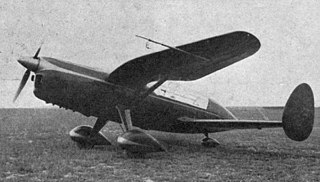
The Delanne 20-T was a French tandem wing aircraft designed as an aerodynamic model for a larger fighter aircraft. It was tested during 1939.
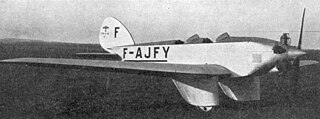
The Albert A-60 was a single engine, two seat, wooden sports monoplane designed and built in France in the early 1930s. Two were built and flown with three different engines.
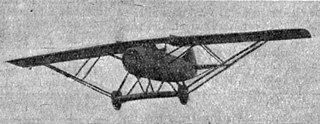
The Salmson-Béchereau SB-5 was a two-seat fighter aircraft built for a French government programme in 1925. Despite a powerful engine it did not perform well and only one was built.
The Bassou Rubis (Ruby) was a low power, robust French aircraft designed for basic training and touring.
The Peitz 101, aka Peitz Avionette, was a French, amateur-built, all-metal light aircraft, first flown during the winter of 1931–32.
The Kellner-Béchereau 23 was a French two seat cabin touring aircraft, built in 1932. Its wing was constructed in a novel way. Only one was completed.
The Morane-Saulnier MS.300 and MS.301 were French parasol wing introductory trainer aircraft, first flown in 1930. They differed only in engine type. Neither reached production but were developed into two similar trainers, the MS.230 and MS.315, which were made in large numbers.

The Couzinet 20 was a low power, three-engined aircraft designed in France in 1929 for postal duties, though it could have been configured to carry three passengers or as a medical transport. Variants flew with three different engines but only two airframes were completed.
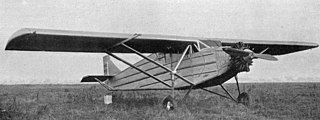
The Aviaméta 92 was a French, all-metal, five seat monoplane built in the late 1920s. Three different engines were fitted, and one example flew the first non-stop Paris-Algiers flight in preparation for an abandoned trans-Atlantic attempt.

The Peyret-Nessler Libellule (Dragonfly) was a French two-seat, low-powered parasol wing light aircraft built in 1927 to provide practical but economical flying. It was one of the first of these French avionettes.
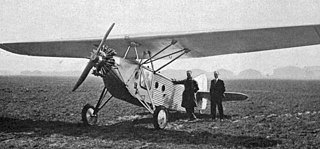
The Hanriot H.46 Styx was a French, single-engined, parasol wing aircraft which could equally be configured for training, liaison or ambulance roles; in the latter form it was able to accept a patient on a stretcher. Several different engines were fitted and flown but the type did not reach production.

The Raab-Katzenstein RK.9 Grasmücke (Hedge-sparrow) was a 1920s German two-seat touring, advertising and training biplane. It was one of many designs from several countries aiming to provide low cost flying and was quite successful, with about twenty built.

The Guerchais-Henriot T-2 was a French low-power, two-seat cabin cantilever monoplane built in 1928. Only one was flown.

The Bourgois-Sénémaud AT was a parasol wing, two seat touring aircraft built in France in 1928. Three examples were completed.